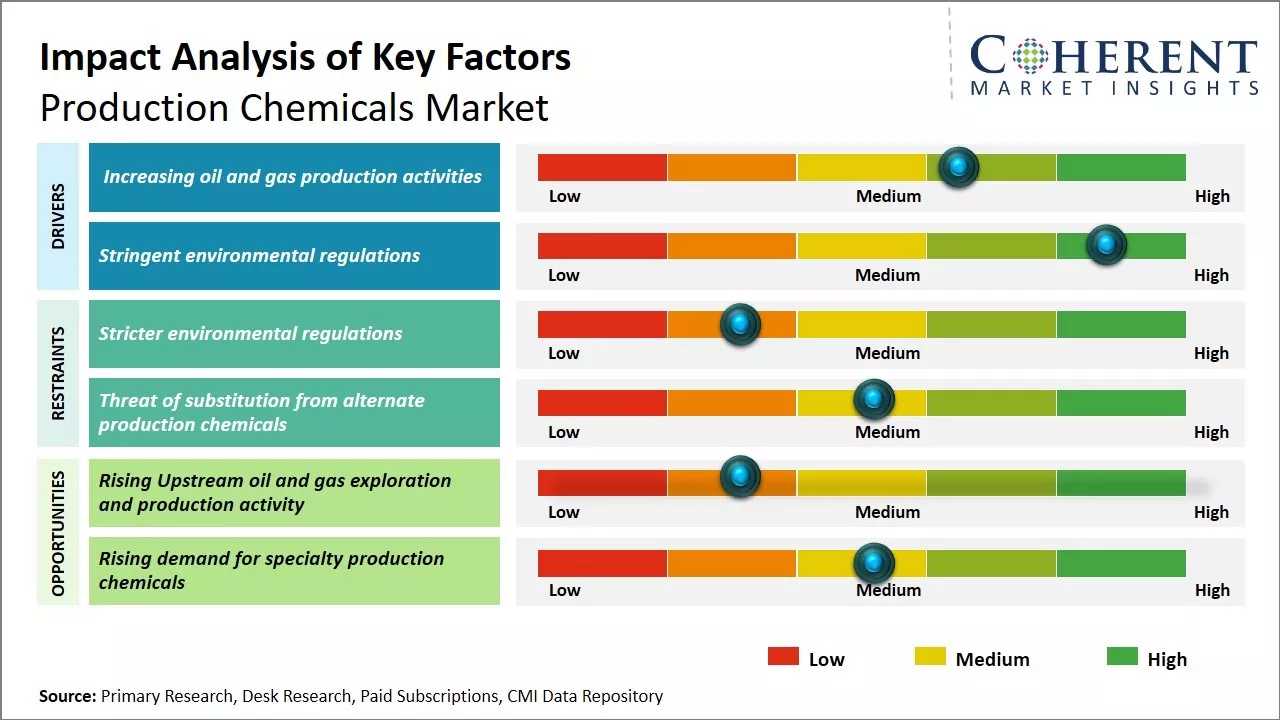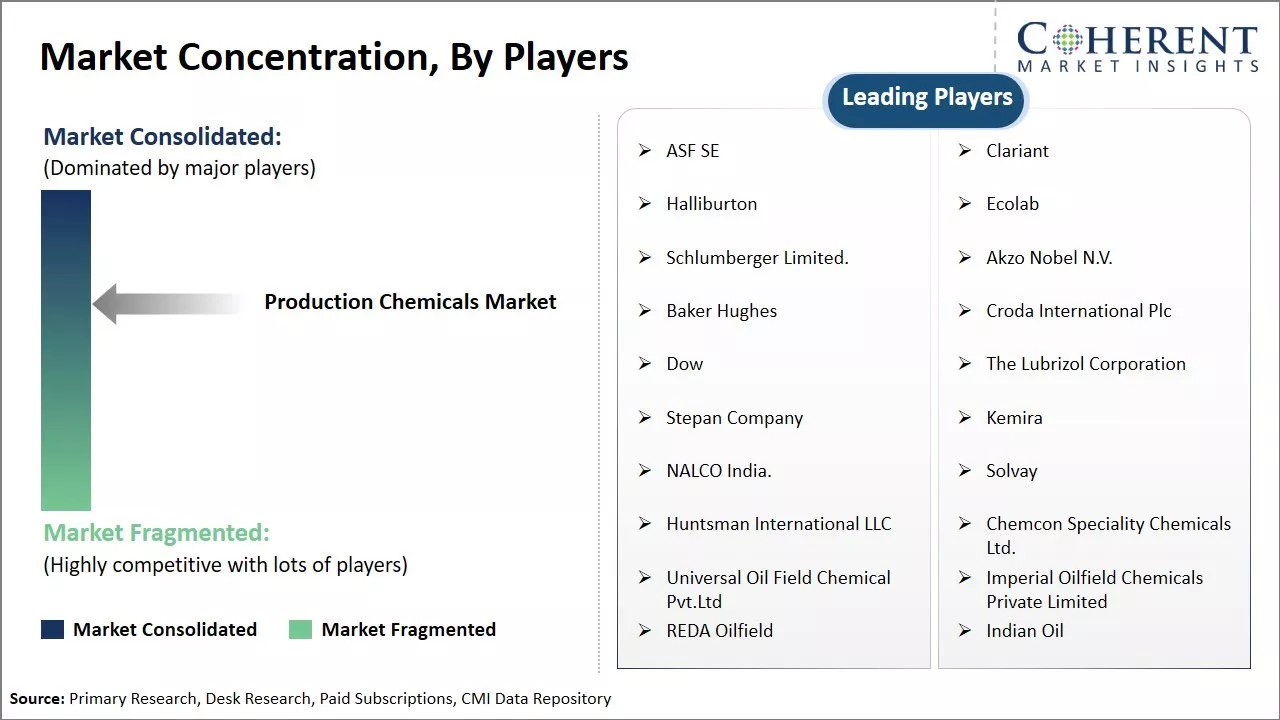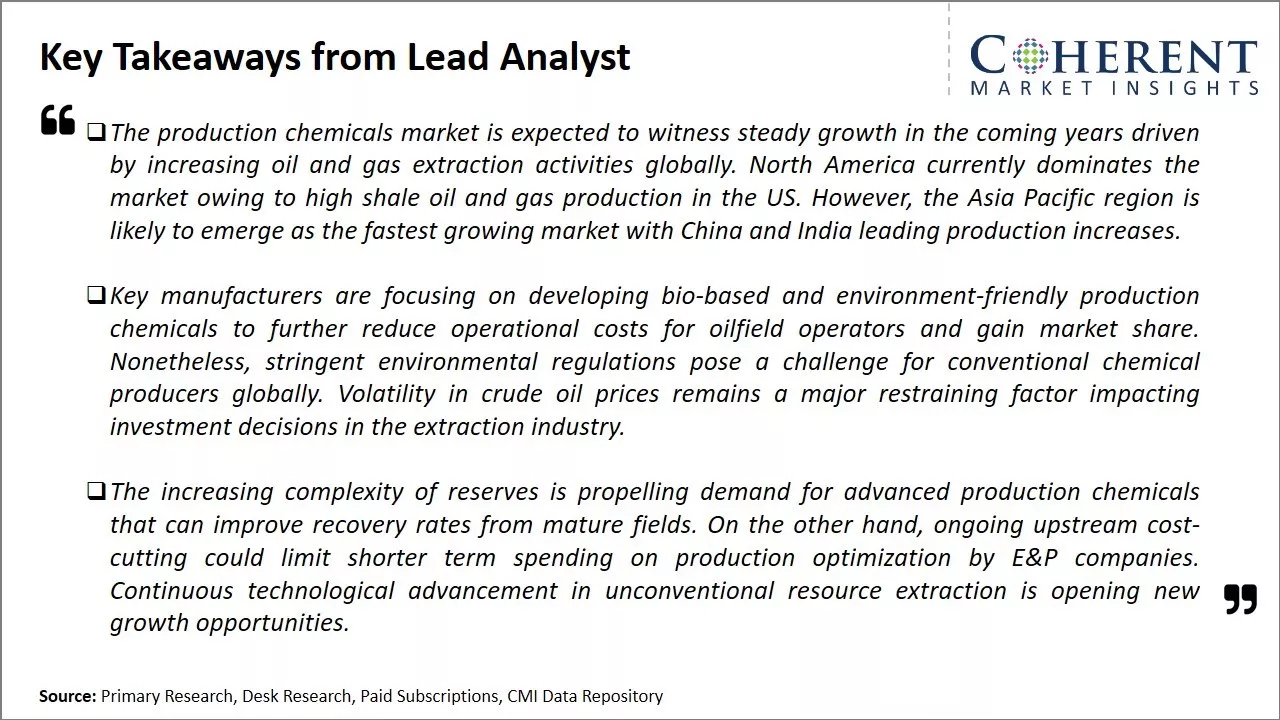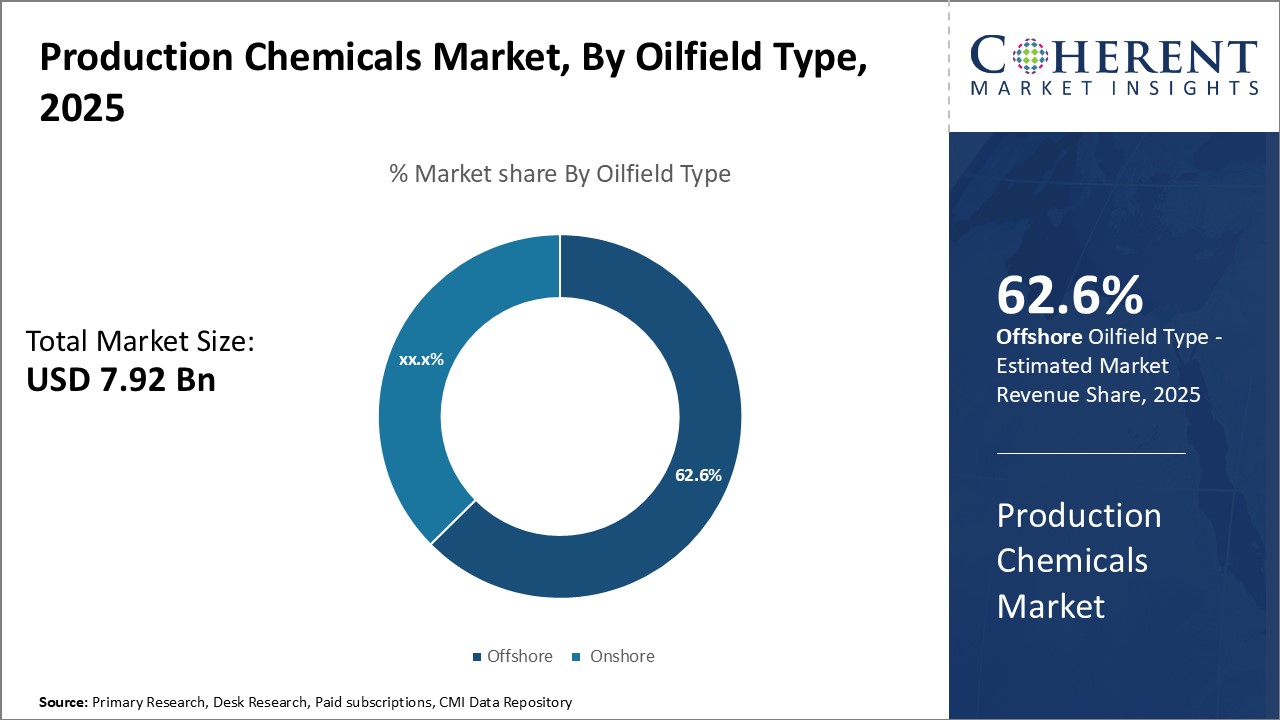The production chemicals market is estimated to be valued at USD 7.92 Bn in 2025 and is expected to reach USD 12.23 Bn by 2032, growing at a compound annual growth rate (CAGR) of 6.4% from 2025 to 2032.

Discover market dynamics shaping the industry: Request sample copy
The production chemicals market is expected to witness significant growth over the forecast period. Rise in oil & gas exploration and production activities is expected to drive the demand for production chemicals. Growing demand from water-treatment plants and refineries is also expected to support the market growth. Further, the increasing demand for energy efficient production processes is projected to boost the consumption of production chemicals. Enhanced oil recovery applications utilizing production chemicals will further augment market expansion through 2032. However, volatility in crude oil prices and stringent regulations regarding environmental safety are factors that can hamper the market growth.
Increasing oil and gas production activities
The demand for production chemicals is closely linked to the level of oil and gas production and exploration activities globally. For instance, according to the Oil & Natural Gas Corporation (ONGC), in India, crude oil production was 1,788.92 TMT in 2020 which is 1.24% higher than in 2019. Over the past few years, there has been a significant rise in investments made by major oil companies as well as national oil companies towards boosting their oil and gas output. Several new large-scale upstream projects are currently underway across all major oil and gas producing regions such as North America, Middle East, Asia Pacific, and Africa. These projects involve the extensive drilling of both onshore and offshore oil and gas wells, which will significantly drive the consumption of a variety of production chemicals. Driven by the continuously rising energy demand worldwide coupled with high oil prices in the past, many upstream companies have aggressively embarked upon enhancing their overall recovery rates from mature oilfields through various improved oil recovery techniques such as hydraulic fracturing, acidizing, cementing etc. This has resulted in growing need for specialty production chemicals that are specifically designed for well stimulation and remediation applications. At the same time, national governments and energy companies across nations are also investing heavily in unlocking unconventional resources such as shale gas, tight gas and oil sands through advanced drilling and production methods. All these factors are expected to substantially boost the application of production chemicals in the coming years.

Get actionable strategies to beat competition: Request sample copy
Stringent environmental regulationsEnvironmental sustainability has become a major priority for regulatory authorities as well as oilfield service providers globally in the past few years. There is growing emphasis on minimizing the ecological and climate change impacts of oil and gas operations through various means such as reduced water usage, lower emission levels, and efficient recycling/disposal of waste streams. This has translated into increasingly stringent environmental regulations being enforced for production chemicals across major markets. As a result, end users are now focused on employing 'eco-friendly' and 'green' substitute products which pose minimal hazardous risks and can aid in achieving sustainability goals.

To learn more about this report, Request sample copy
Market Challenges: Stricter environmental regulationsThe production chemicals market faces several challenges. Strict environmental regulations have increased operational costs for manufacturers and limited the use of certain hazardous chemicals. Substitute products from local and regional manufacturers also provide tough competition on pricing. Additionally, fluctuating raw material costs adversely impact margins. Identifying greener substitutes and optimizing formulations to reduce consumption are active areas that need attention to overcome these regulatory and cost headwinds.
Market Opportunities: Rising upstream oil and gas exploration and production activity
Upstream oil and gas exploration and production activity is rising globally, offering increased demand of production chemicals. Other core industries like mining, water treatment, and power also rely heavily on production chemicals and are expanding their output. Scale benefits and value-added services like on-site expertise and customized blends allow players to command a pricing premium over commodity chemicals.

Discover high revenue pocket segments and roadmap to it: Request sample copy
Insights, By Oilfield Type: Robust investment in offshore oil and gas operationsIn terms of oilfield type, offshore contributes 62.6% share of the market owing to substantial investments in offshore exploration and production activities. Offshore oilfields require specialized production chemicals that can withstand harsh conditions like high pressure and temperatures at the seabed. Compared to onshore fields, offshore reserves often contain thicker crude that is difficult to extract and transport. This has prompted major oil companies to invest heavily in technologically advanced offshore rigs, pipelines, and support vessels. Countries like the U.S., Brazil, the U.K., Norway, and Australia have seen a rise in deepwater and ultra-deepwater projects as such reserves hold higher potential. Production chemicals play a vital role in extracting oil from reservoirs situated miles below the sea surface in an efficient and cost-effective manner. Demand for products like demulsifiers, scale inhibitors, and fluid loss additives has surged from offshore operators to boost recovery rates from mature fields as well as optimize processes in newer offshore projects. Government initiatives in various nations to increase offshore fossil fuel production through bidding rounds and field auctions have further spurred uptake of specialized production chemical formulations. Looking ahead, the segment is expected to capture a significant market share as offshore reserves still have vast untapped potential, Hence, increasing crude oil production and investment is estimated to grow the consumption of production chemicals. According to the Canadian Association of Petroleum Producers (CAPP), capital investment in Alberta’s oil sands is expected to increase from US$6.7 billion in 2020 to US$7.3 billion in 2021.
Insights, by Type: Water management needs drive demulsifier sales
Among different types, demulsifiers contributes 36.1% share of the market due to extensive applications in separating water from crude oil during production operations. During extraction, water often gets emulsified or mixed with the crude stream making separation a major challenge. Left unattended, water carryover can damage downstream refining units and reduce throughput. It also raises transportation and storage costs. Hence, producers rely heavily on demulsifiers to break the emulsion and allow for a clear phase separation of oil and water phases. Their usage has become integral across onshore and offshore facilities to remove moisture and contaminants from crude before transport through pipelines or tankers. In mature oilfields facing higher water cuts, demulsifiers play a pivotal role in optimizing declines and extending field life. Growing complexities in feedstock characteristics with the development of unconventional reserves have augmented the significance of demulsification processes. This has positively impacted sales of high-performance demulsifier formulations engineered specifically for tougher conditions involving high salinity, hardness, and temperatures. Consequently, demulsifiers remain the dominant segment in the production chemicals landscape.
Insights, by Application: EOR practices drive improved oil recovery chemical demand
In terms of application, improved oil recovery contributes 49.6% share of the market due to the active deployment of Enhanced Oil Recovery (EOR) techniques. Mature reservoirs lose substantial amounts of original oil in place despite primary and secondary recovery owing to highly viscous oil trapped in pore spaces. EOR practices like polymer flooding, surfactant flooding and low tension gas flooding are being adopted on a wide scale to mobilize these unwanted reserves. Production chemicals have a profound role to play in such processes by lowering interfacial tension, controlling fluid viscosity and altering rock wettability. Polymers are used as viscosifiers, surfactants act as mobility control agents while others inhibit corrosion or scales in production streams. Estimates show EOR methods can potentially add billions of barrels to global reserves. As a result, oil companies are investing heavily in chemical EOR projects involving polymers, surface active agents and specialty additives. Additionally, inefficient water flooding operations in aging fields are driving use of scale inhibitors, biocides and other chemicals meant for improved sweep efficiency. The burgeoning EOR industry thus drives strong demand for innovative chemical formulations facilitating higher recovery of original oil in place.

Need a Different Region or Segment? Customize now
North America has been the dominant force in the global production chemicals market with 46.1% of the market share, driven by the size and maturity of the oil and gas industry based in the U.S. and Canada. The region is home to many industry-leading oilfield service companies that have pioneered production optimization techniques and produced a variety of proprietary chemistries for maximizing hydrocarbon recovery rates. This strong base of technological expertise and intellectual property in the production chemicals domain has cemented North America's leadership position. Additionally, the prevalence of older legacy oil fields that require sophisticated chemical-based enhanced oil recovery methods to prolong their productive lives has sustained high demand for production chemicals from local oil producers. However, the regional market is now facing increasing competition from abroad as intellectual property protections expire and foreign firms catch up technologically.
The Middle East market has emerged as the fastest growing regional market for production chemicals. Countries in the Persian Gulf such as Saudi Arabia and the U.A.E hold vast reservoirs of untapped oil reserves that national oil companies are actively working to develop and monetize. This presents a major opportunity for production chemical providers to supply polymers, corrosion inhibitors, scale inhibitors, and other materials to facilitate optimal extraction from these newly online fields. While the regional market was traditionally supplied through North American and European imports, local content regulations instituted by Gulf nations are driving the establishment of production chemical production hubs and technical service centers in the Middle East by international industry players. Reliance on imported production chemicals is giving way to locally manufactured solutions. This is transforming the Middle East into a strategically important production chemicals market with immense potential for further growth.
Production Chemicals Market Report Coverage
| Report Coverage | Details | ||
|---|---|---|---|
| Base Year: | 2024 | Market Size in 2025: | USD 7.92 Bn |
| Historical Data for: | 2020 To 2024 | Forecast Period: | 2025 To 2032 |
| Forecast Period 2025 to 2032 CAGR: | 6.4% | 2032 Value Projection: | USD 12.23 Bn |
| Geographies covered: |
|
||
| Segments covered: |
|
||
| Companies covered: |
ASF SE, Clariant, Halliburton, Ecolab, Schlumberger Limited., Akzo Nobel N.V., Baker Hughes, Croda International Plc, Dow, The Lubrizol Corporation, Stepan Company, Kemira, NALCO India., Solvay, Huntsman International LLC, Chemcon Speciality Chemicals Ltd., Universal Oil Field Chemical Pvt.Ltd, Imperial Oilfield Chemicals Private Limited, REDA Oilfield, and Indian Oil |
||
| Growth Drivers: |
|
||
| Restraints & Challenges: |
|
||
Uncover macros and micros vetted on 75+ parameters: Get instant access to report
*Definition: The production chemicals market consists of various chemicals that are used during the extraction and processing of oil and gas. These chemicals improve extraction, reduce corrosion and scale, decrease friction, and enhance productivity and efficiency. Some examples of production chemicals include biocides, corrosion and scale inhibitors, coagulants and flocculants, combustion and lubricity modifiers, and fluids for hydraulic fracturing. Production chemicals play a vital role in maximizing recovery from oil and gas reservoirs and lowering overall production costs for energy companies.
Share
Share
About Author
Yash Doshi is a Senior Management Consultant. He has 12+ years of experience in conducting research and handling consulting projects across verticals in APAC, EMEA, and the Americas.
He brings strong acumen in helping chemical companies navigate complex challenges and identify growth opportunities. He has deep expertise across the chemicals value chain, including commodity, specialty and fine chemicals, plastics and polymers, and petrochemicals. Yash is a sought-after speaker at industry conferences and contributes to various publications on topics related commodity, specialty and fine chemicals, plastics and polymers, and petrochemicals.
Missing comfort of reading report in your local language? Find your preferred language :
Transform your Strategy with Exclusive Trending Reports :
Frequently Asked Questions
Joining thousands of companies around the world committed to making the Excellent Business Solutions.
View All Our Clients
US Reciprocal Tax Impact Analysis On Production Chemicals Market
Stay updated on tariff changes with expert insights and timely information